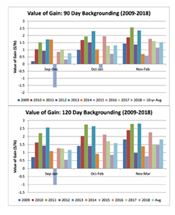Marketing Calves In The Fall Or Preconditioned Cattle In January
DR. ANDREW P. GRIFFITH
KNOXVILLE, TENN.
The fall calf market is quickly approaching. Spring calving herds generally market calves straight off the cow in September, October, and November which results in these months having the biggest run of cattle in most states including Tennessee. This situation always brings to light the question of when to market these calves and if preconditioning these cattle is worth the time, effort and additional capital. Thus, it may be beneficial to look back at the past few years to see how management decisions would have impacted a producer’s bottom line.
This article is not going to look at the cost of maintaining calves after weaning, because the cost structure of each operation varies widely. What this article is going to consider is the value of gain. Thus, the scenarios being considered include weaning a 550 pound calf in September, October, or November and then preconditioning the calf for 90 days or 120 days and then marketing the calf at 650 pounds. Thus, a steer weaned in September and preconditioned 90 days will be marketed as a 650 pound steer in December while a 120 day preconditioning phase will put the calf being marketed in January. It is important to note that the 90 day preconditioning period assumes an average daily gain just over 1.0 pound per day while the 120 day period assumes less than 1.0 pound per day. Additionally, the year denoted in the accompanying graphs represent the year the calf was born.
Considering the 90 day preconditioning period (see graph), the value of gain from September to December averaged $0.77 per pound of gain from 2009 to 2018 while the October to January ($1.31 per pound) and November to February ($1.54 per pound) were more favorable over the ten years analyzed. The only negative value occurred when the extremely high market of 2015 collapsed in early 2016. Eight out of ten years, the October to January and the November to February preconditioning periods had value of gains that were $1.00 or higher while there were only four years in which the value of gain exceeded $1.00 from September to December.
Now looking at the 120 day preconditioning period, carrying 550 pound steers to 650 pounds from September to January had an average value of gain near $1.17 per pound from 2009 to 2018 with seven out of the ten years exceeding $1.00 per pound. The value of gain from October to February averaged $1.59 per pound over the past ten years while the value of gain from November to March averaged $1.82 per pound. Seven out of ten years the October to February time period saw the value of gain exceed $1.00 per pound while the November to March time period saw eight out of ten years from 2009 to 2018.
The rate of gain used in this short article is much lower than most people generally shoot for when backgrounding cattle. However, good moisture this summer resulted in a lot of hay production during 2019 which means many producers have a feed source that will not require extra capital to background cattle and that will not push cattle hard. Thus, producers who generally market calves in the fall straight off the cow and that have additional hay supplies may want to consider the value of keeping these animals a few extra months and adding a few extra pounds prior to marketing.
The 90 day preconditioning from September to December does not look favorable from a historical perspective, but the other alternatives presented in this article do look enticing. The key to this system is the seasonal increase in lighter weight cattle to go on grass. Thus, the closer the market moves to spring turnout on grass, the higher the price goes for grass cattle. It may be worth the risk this year to see what a person can do by holding cattle a few extra months. ∆
DR. ANDREW P. GRIFFITH: Assistant Professor, Department of Agricultural and Resource Economics, University of Tennessee
